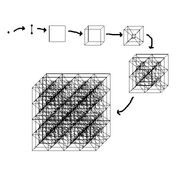
Dimensions 0 to 6 displayed simultaneously.
Spatial dimensions are the dimensions used in many fields of mathematics.
Dimensions[]
Dimension 0—a mathematical point[]
Dimension 0 is literally a point in space. Points can be described by coordinates, (x, y), and graphed on a coordinate plane. Since a 0-dimensional object has neither length, width, nor depth, it is immeasurable.
Vertices*: 20 = 1
Total Possible Lines†: (1 * 0)/2 = 0
Dimension 1—a line[]
Dimension 1 is any two 0-dimensional points connected with a line, ray, or segment. A 1-dimensional object can only be measured in length. If you were a 0-dimensional object looking at a 1-dimensional line, you would see a point that appears and disappears where the line is. In other words, the line would appear in cross-sections of points. 1-dimensional lines can stretch for an eternity.
Vertices: 21 = 2
Total Possible Lines: (2 * 1)/2 = 1
Dimension 2—a flat plane[]
Dimension 2 is at least two 1-dimensional lines that either connect or intersect to form a plane. A plane has width and length. To a 1-dimensional line, a plane appears as both lines and points.
Vertices: 22 = 4
Total Possible Lines: (4 * 3)/2 = 6
Dimension 3—3-dimensional space[]
Dimension 3 is at least two planes that either connect or intersect to form 3-dimensional space. 3-dimensional space has length, width, and height. A 2-dimensional plane would see space as a cross section of definite 2-dimensional shapes.
Vertices: 23 = 8
Total Possible Lines: (8 * 7)/2 = 28
Dimension 4—4-dimensional space[]
4-dimensional space is made when at least two 3-dimensional spaces converge and/or intersect. Imagining this dimension and onwards is notoriously difficult for our minds to conjure, with each new dimension becoming increasingly complex and consequentially harder to conjure.
Vertices: 24 = 16
Total Possible Lines: (16 * 15)/2 = 120
Dimensions 5 and Above—x-dimensional space[]
Each dimension after dimension 4 is a more complex version of space than the previous. For example, 5-dimensional space is made by intersecting multiple 4-dimensional spaces, and 6-dimensional space is made by intersecting multiple 5-dimensional spaces, and so on and so forth.
For dimension 5,
Vertices: 25 = 32
Total Possible Lines: (32 * 31)/2 = 496
For dimension 6,
Vertices: 26 = 64
Total Possible Lines: (64 * 63)/2 = 2,016
For dimension 7,
Vertices: 27 = 128
Total Possible Lines: (128 * 127)/2 = 8,128
For dimension 8,
Vertices: 28 = 256
Total Possible Lines: (256 * 255)/2 = 32,640
For dimension 9,
Vertices: 29 = 512
Total Possible Lines: (512 * 511)/2 = 130,816
(For more info on these calculations, consult notes * and †.)
See Also[]
Notes[]
*You can calculate the number of vertices an x-dimensional cube has with 2x.
†All the possible unique lines that can be drawn between each of the vertices. You can calculate this using , where x is the number of dimensions.








